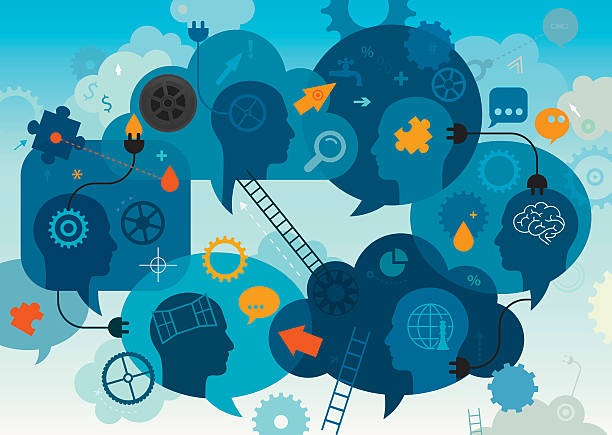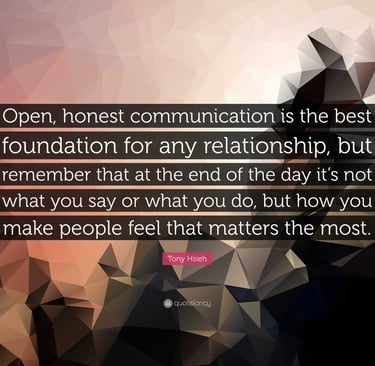

Communication Empowers
Empowering Expression, Elevating Experience, Empowering Voices, Connecting Minds
Communication: The Strategic Foundation of Success
Quality is not an act; it’s a habit. It's not something we just strive for; we live by this principle every day.


Communication is the process of conveying information, thoughts, and feelings between individuals, encompassing verbal, nonverbal, written, and visual forms, all aimed at creating shared understanding. It is the purposeful exchange of information, ideas, and feelings between individuals, encompassing verbal, nonverbal, written, and visual forms, all aimed at creating a shared understanding.
A more comprehensive understanding of communication refers to the sharing of information, ideas, and feelings, typically aimed at mutual understanding. In this way, you must consider the sender, the recipient, and the transaction. Simply put, the sender is the person sharing the message, the recipient is the person receiving and interpreting the message, and the transaction is the way that the message is delivered and the factors that influence the context and environment of the communication.
Communication is complex. It involves more than just what you say and takes many forms. Our work life is consumed by communication; there is no escaping it. Whether drafting emails and documents, taking meetings by phone, Zoom, and in person, or managing a constant stream of Slack notifications, we’re all moving business forward through communication. Good business communication is a strategic imperative to fuel success in today’s competitive landscape.
Communication is the strategic foundation of all business success—a complex, multifaceted process that goes far beyond simple information exchange. At its core, communication involves the purposeful sharing of information, ideas, and feelings through verbal, nonverbal, written, and visual forms, all designed to create genuine understanding between people.
Every communication event requires three essential elements: the sender who crafts and delivers the message, the recipient who receives and interprets it, and the transaction itself—the method of delivery along with all the contextual factors that influence how the message is understood. In today's fast-paced business environment, where our work lives are consumed by a constant flow of emails, documents, video calls, and digital notifications, effective communication isn't just helpful—it's a strategic imperative that directly fuels competitive advantage and organizational success.
This website serves as an essential resource for anyone looking to master the art and science of effective professional communication. It comprehensively explores the foundational principles and practical strategies essential for clear, concise, impactful communication, in addition to mastering written correspondence such as emails and reports, as well as perfecting verbal presentations, negotiation skills, and team collaboration. This platform aims to equip users with the tools necessary to navigate diverse communication scenarios successfully. Ultimately, This site underscores how strong business communication is. It's not merely about exchanging information but about building relationships, fostering understanding, and driving organizational success, making it an indispensable guide for students, budding professionals, and seasoned executives alike.
Effective Communication Is Key
"The single biggest problem in communication is the illusion that it has taken place." George Bernard Shaw.
Enhancing Team Collaboration:
Shared Understanding: Effective communication ensures that everyone is on the same page, minimizing misunderstandings and enabling teams to work efficiently towards common goals.
Problem-Solving and Innovation: Active listening allows individuals to better understand problems and work with others to develop creative solutions, fostering innovation.
Conflict Resolution: Communication skills are essential for addressing and resolving workplace conflicts constructively, preserving relationships, and maintaining a productive work environment.
Boosting Confidence and Adaptability:
Self-assurance: When individuals can communicate their thoughts clearly and receive positive responses, it builds confidence and enhances their professional presence.
Adaptability: Knowing how to tailor your message to different audiences, whether colleagues, executives, or clients, is a powerful skill that helps you connect with others effectively and adapt to different situations.
Overcoming Communication Barriers: Organizations can empower employees by providing language training, cultural awareness programs, and minimizing distractions to overcome communication barriers and foster clearer communication.
Professional Development:
Continuous Learning: Engaging in communication skills training, attending workshops, or participating in mentorship programs empowers employees with the skills and knowledge needed to excel in their roles.
Seeking Feedback: Actively seeking feedback on your communication style allows you to identify areas for improvement and refine your skills, ultimately leading to greater professional growth.
Effective communication is key to unlocking opportunities and enhancing growth throughout one's professional journey. Whether it's articulating ideas, building relationships, or navigating challenges, communication plays a vital role in empowering individuals throughout their careers. By honing their communication skills, individuals can convey their expertise, collaborate effectively with colleagues, and showcase their value to employers. Embracing transparent and open communication fosters trust, encourages innovation, and paves the way for success in the ever-evolving workplace landscape. Recognizing the importance of communication empowers individuals to confidently express themselves, establish connections, and drive their careers forward with clarity and impact. Communication plays a vital role in empowering individuals throughout their careers, impacting their ability to succeed and grow professionally. It's a foundational skill that influences nearly every aspect of professional life, from daily interactions to career advancement. The following illustrates how communication empowers individuals in their careers:
Building Strong Relationships:
Trust and Collaboration: Effective communication fosters transparency and honesty, building trust and strengthening relationships with colleagues, clients, and superiors.
Networking: Good communication skills are crucial for networking, enabling individuals to build connections, share ideas, and explore new opportunities.
Team Cohesion: When individuals can articulate their thoughts clearly, listen actively, and provide constructive feedback, it enhances team collaboration and creates a cohesive work environment.
Advancing Career Opportunities:
Leadership and Influence: Strong communication is a hallmark of great leadership, enabling individuals to articulate their vision, provide clear direction, and motivate teams.
Career Visibility and Recognition: Individuals who communicate effectively often stand out to their superiors, showcasing their value to the organization through presentations, reports, and clear articulation of achievements.
Presentation and Negotiation Skills: Effective communication empowers individuals to deliver impactful presentations, negotiate effectively, and influence others, all of which contribute to career advancement.


Communication Complexity
“The biggest communication problem is we do not listen to understand. We listen to reply.” Stephen R. Covey
Communication complexity emerges from the intricate process of encoding and decoding meaning across multiple channels simultaneously. When individuals communicate, they must translate their internal thoughts, emotions, and intentions into symbols—whether words, gestures, or visual cues—that another person must then interpret through their unique lens of experience, knowledge, and cultural background. This translation process is inherently imperfect because no two people share identical frames of reference, and the meaning we intend to convey may differ significantly from what others understand. The challenge intensifies when considering that communication operates on multiple levels concurrently: verbal content, tone of voice, facial expressions, body language, timing, and contextual factors all contribute layers of meaning that can reinforce, contradict, or modify the primary message being transmitted.
The complexity deepens through the influence of psychological and environmental filters that shape both message delivery and reception. Each participant brings their emotional state, past experiences, cultural values, education level, and personal biases to every interaction, creating a unique interpretive framework that influences how messages are both sent and received. Power dynamics, social hierarchies, physical environments, and external distractions further complicate the communication process by adding contextual pressure that can alter meaning or create barriers to understanding. Additionally, the feedback loops inherent in communication create a dynamic, constantly shifting process where individuals simultaneously process incoming information while formulating responses, leading to real-time adjustments that can either clarify or further complicate the intended message.
The Illusion of Understanding:
It's easy to assume someone understands what you've said, even if they don't, according to a quote by George Bernard Shaw.
Individual Differences:
People communicate differently, with varying styles and preferences, making it difficult to ensure everyone understands the same message.
Context Matters:
Communication can be influenced by the situation, including the environment, making it difficult to ensure everyone understands the same message: emotions and relationships between individuals.
Nonverbal Communication:
Tone of voice, body language, and facial expressions all contribute to the overall meaning of a message, and misinterpretations can occur easily.
Technical and Specialized Language:
Workplaces often use jargon and technical terms that may not be understood by everyone, creating communication barriers.
Emotional Intelligence:
Understanding and managing emotions is crucial for effective communication, especially in complex workplace situations.


Why Honest Communication Matters
Honest communication is built on truth and integrity and upon respect of the one for the other. Benjamin E. Mays
However, honest communication does not equate to brutality or insensitivity. It is essential to deliver truth with empathy and consideration for the other person's feelings. This involves choosing appropriate timing, using respectful language, and being mindful of non-verbal cues. The goal of honest communication should be to build understanding and resolve issues, not to inflict pain or damage relationships. Furthermore, honest communication requires active listening. It's not enough to simply express oneself truthfully; one must also be willing to genuinely hear and understand the other person's perspective, even if it differs from their own. This involves paying attention, asking clarifying questions, and reflecting on what has been said.
Honest communication is the bedrock of successful relationships, both personal and professional. It involves expressing oneself truthfully and directly, without resorting to manipulation or evasiveness. While it may sometimes feel challenging to be completely candid, particularly when delivering difficult news or navigating sensitive situations, the long-term benefits of honest communication far outweigh the potential discomfort. Within personal relationships, honest communication is equally crucial for building and maintaining intimacy and connection. It allows individuals to truly understand each other's needs, feelings, and perspectives. When communication is honest, it minimizes misunderstandings and prevents the buildup of resentment that can occur when emotions are left unexpressed or suppressed. While it may require vulnerability to share one's true thoughts and feelings, this openness deepens bonds and strengthens the foundation of the relationship.
Honest communication is a vital skill for navigating both our personal and professional lives effectively. While it may present challenges, the benefits of fostering trust, transparency, and genuine connection are invaluable. By committing to expressing ourselves truthfully and respectfully and by actively listening to others, we can build stronger relationships, resolve conflicts more effectively, and create a more positive and productive environment for everyone involved. It is a continuous practice that requires conscious effort, but the rewards of honest communication are immeasurable.
In the workplace, honest communication fosters a culture of trust and transparency. When employees feel comfortable expressing their thoughts and concerns openly, it leads to increased collaboration, innovation, and problem-solving. Conversely, a lack of honesty can breed suspicion, resentment, and ultimately, a decline in productivity and morale. Managers who prioritize honest communication build stronger teams and create an environment where employees feel valued and respected. This includes providing constructive feedback clearly and directly, acknowledging mistakes openly, and being transparent about company performance and decisions.


Building Trust and Strengthening Relationships
Cultivating a culture of honesty requires conscious, sustained effort beginning with leadership modeling transparency and admitting mistakes while creating safe spaces for employee expression without fear of repercussions. Organizations must invest in training programs that teach effective communication skills, including active listening, assertive communication, and conflict resolution techniques that emphasize the importance. Overcoming barriers to honest communication involves addressing fear of judgment, potential conflict, and perceived power imbalances by creating psychological safety where individuals feel comfortable taking risks and sharing perspectives, supported by clear communication channels such as regular meetings, feedback sessions, and anonymous reporting mechanisms that ensure all voices are heard and concerns are addressed promptly.
Effective Communication
Communication is indeed a powerful tool, impacting everything from individual relationships to organizational success.
Open communication of feelings helps build trust and reduce misunderstandings by sharing thoughts and experiences honestly. Active listening shows respect for others' feelings, fostering empathy and trust. Authentic emotional expression creates genuine connections, while a safe environment encourages sharing vulnerabilities. Recognizing different communication styles is important, as is being present and mindful during interactions. Demonstrating empathy and compassion supports the emotional state of others, and using physical and verbal affection strengthens closeness. Learning from each other’s perspectives enhances understanding. Authenticity encourages openness, while empathy helps relate to others' experiences. Nonverbal cues, such as body language and eye contact, enhance emotional communication. Sharing personal stories fosters intimacy and deeper connections. Positive reinforcement builds confidence and appreciation. Identifying shared goals and values creates unity, enhancing communication skills and emotional connections in both personal and professional settings. Embracing these communication strategies can significantly enhance personal and professional relationships.
Effective communication hinges on several key principles. Firstly, clarity is essential; use straightforward language and avoid jargon unless necessary. Active listening involves fully focusing on the speaker, demonstrating understanding through acknowledgment, and asking clarifying questions when needed. Nonverbal communication should be synchronized with verbal messages, paying attention to body language and eye contact. Additionally, adjusting tone to fit the context while remaining calm and respectful is vital, as is recognizing emotional undertones in conversations. Constructive feedback is important for improving communication and facilitating clarification of misunderstandings. Empathy and respect towards others' perspectives and boundaries enhance interactions, along with selecting the appropriate medium for the message based on urgency and context. Understand the purpose of your communication and tailor it to your audience's needs. Lastly, timing is crucial; deliver messages promptly and allow time for discussion while communicating confidently without aggression.
Effective communication is essential for building trust and fostering emotional connections. Strategies such as open communication, active listening, and authentic emotional expression contribute significantly to creating a safe environment. Recognizing individual communication styles and being mindful of nonverbal cues enhance interactions, while empathy and compassion support the emotional states of others.
Authenticity and vulnerability play crucial roles in establishing intimacy and strengthening relationships. In addition to these strategies, physical and verbal affection can enhance emotional closeness. Positive reinforcement of contributions instills confidence, while identifying shared goals and values fosters unity. By implementing these principles, individuals can improve their communication skills and deepen their connections with others in both personal and professional settings.


Transformative Power of Creative Communication
Creative communication changes ordinary messages into engaging ones, making them more memorable and ensuring the audience grasps the essential information.
Creative communication possesses transformative power because it breaks through the noise and monotony of conventional messaging to capture attention and create lasting impact. In a world saturated with information, creative approaches help messages stand out by engaging multiple senses, emotions, and cognitive processes simultaneously. When communicators use storytelling, vivid imagery, unexpected analogies, or innovative formats, they activate different areas of the brain and create memorable experiences that stick with audiences long after the interaction ends. This enhanced memorability translates into real influence, as people are more likely to act on messages that have emotionally resonated with them or sparked their imagination. Creative communication also demonstrates respect for the audience by investing extra effort to make information engaging and accessible, which builds credibility and strengthens the communicator's influence.


Creativity is crucial in business communication, as it enables businesses to communicate effectively, foster innovation, and differentiate themselves from competitors. By incorporating creative approaches, businesses can engage audiences, improve employee morale, and achieve better outcomes. Creative communicators can paint vivid pictures of desired futures.
Creativity plays a crucial role in enhancing business communication by engaging stakeholders effectively and improving employee morale. By crafting compelling narratives and innovative messages, businesses can connect with employees, customers, and investors on a deeper level. Creative communication not only boosts employee loyalty and productivity but also helps organizations differentiate themselves from competitors in a saturated market. This approach encourages collaboration and sparks innovative ideas, leading to improved products and services.
Creativity plays a crucial role in enhancing business communication by engaging stakeholders effectively and improving employee morale. By crafting compelling narratives and innovative messages, businesses can connect with employees, customers, and investors on a deeper level. Creative communication not only boosts employee loyalty and productivity but also helps organizations differentiate themselves from competitors in a saturated market. This approach encourages collaboration and sparks innovative ideas, leading to improved products and services.
Examples of creative communication include dynamic branding and advertising strategies that utilize visuals and storytelling, collaborative brainstorming for product development, and engaging internal communications to celebrate achievements. Additionally, creative approaches in public relations can effectively manage perceptions during crises, while personalized customer service interactions foster loyalty. Ultimately, businesses that prioritize creativity in their communication strategies drive growth, strengthen connections, and achieve their objectives.
Active Listening and Creative Communication
“I remind myself every morning: Nothing I say this day will teach me anything. So if I’m going to learn, I must do it by listening.” —Larry King
Active listening forms the cornerstone of effective creative communication, serving as both a catalyst for innovation and a bridge between diverse perspectives. Unlike passive hearing, active listening requires full engagement with the speaker, involving careful attention to not only their words but also their tone, emotions, and underlying messages. In creative environments, this heightened awareness allows team members to pick up on subtle cues that might spark new ideas or reveal hidden connections between seemingly unrelated concepts. When creative professionals truly listen to one another, they create a foundation of trust and psychological safety that encourages risk-taking and the free flow of imaginative thinking.


Active listening can be broken down into various types or styles, each with a specific focus. These include empathetic listening, comprehensive listening, critical listening, and appreciative listening. Each type involves different techniques and goals, but all aim to improve communication and understanding between individuals. By practicing these techniques and understanding the different types of active listening, individuals can significantly improve their communication skills and build stronger relationships.
Different Types of Active Listening:
Empathetic Listening: This involves listening to understand the speaker's feelings and perspective, putting yourself in their shoes to grasp their emotional state. It's about validating their experience and showing genuine care.
Comprehensive Listening: This focuses on understanding the information being conveyed, whether it's a set of instructions, a complex idea, or a detailed explanation. It often involves asking clarifying questions and summarizing key points.
Critical listening involves evaluating the speaker's message, analyzing their arguments, and forming your own informed opinion. It's not about finding fault but about assessing the validity and logic of the presented information.
Appreciative Listening: This type of listening focuses on enjoying the message or the speaker's delivery. It could be listening to music, a captivating story, or a passionate speech.
Active Listening Techniques:
Regardless of the specific type of active listening, certain techniques are crucial for effective communication.
Pay attention:
Focus on the speaker, both verbally and nonverbally, and avoid distractions.
Show that you're listening:
Use nonverbal cues such as eye contact, and appropriate facial expressions to demonstrate engagement.
Provide feedback:
Summarize, paraphrase, and ask clarifying questions to ensure understanding.
Defer judgment:
Avoid interrupting or forming counterarguments prematurely.
Respond appropriately:
Be respectful and thoughtful in your responses, demonstrating that you have listened and understood.
Encompassing four distinct styles, each serving specific communication purposes: empathetic listening for understanding emotions and perspectives, comprehensive listening for grasping information and instructions, critical listening for evaluating arguments and validity, and appreciative listening for enjoying the message or delivery.
Effective, active listening relies on core techniques including paying focused attention, demonstrating engagement through nonverbal cues, providing feedback through questions and paraphrasing, deferring judgment to avoid premature responses, and responding thoughtfully and respectfully. Mastering these approaches and techniques enhances communication skills and strengthens interpersonal relationships. By practicing these techniques and understanding the different types of active listening, individuals can significantly improve their communication skills and build stronger relationships.
Genuine Engagement in Communication
This type of engagement can lead to stronger relationships, better problem-solving, and a more positive overall experience for everyone involved.
Cultivating genuine engagement requires deliberate practice through self-reflection to understand your own values and communication patterns, actively listening with full attention and seeking clarification, being open and honest while embracing vulnerability, building empathy for others' emotions, using "I" statements to express feelings without blame, aligning your words with your actions, seeking and offering constructive feedback, using effective non-verbal cues, and staying present during conversations. The benefits of this approach include stronger relationships built on trust, improved communication with reduced misunderstandings, increased engagement and motivation, better teamwork and collaboration, higher productivity with fewer errors, and enhanced well-being through reduced stress and increased feelings of belonging. Genuine engagement in communication also involves being authentic, transparent, and respectful in your interactions to build trust and foster meaningful connections. By focusing on these principles and actively working to incorporate them into communication, the ability to connect with others and foster more authentic and fulfilling relationships can be improved.
Genuine engagement in communication centers on authenticity, transparency, and respect to build trust and create meaningful connections. The key characteristics include being true to yourself while expressing thoughts and feelings sincerely, maintaining openness and honesty in your messages, practicing active listening and empathy to understand others' perspectives, showing respect for differing opinions, embracing vulnerability by sharing your true self, ensuring consistency between words and actions, and communicating with clarity and conciseness.
Cultivating genuine engagement requires deliberate practice through self-reflection to understand your own values and communication patterns, actively listening with full attention and seeking clarification, being open and honest while embracing vulnerability, building empathy for others' emotions, using "I" statements to express feelings without blame, aligning your words with your actions, seeking and offering constructive feedback, using effective non-verbal cues, and staying present during conversations. The benefits of this approach include stronger relationships built on trust, improved communication with reduced misunderstandings, increased engagement and motivation, better teamwork and collaboration, higher productivity with fewer errors, and enhanced well-being through reduced stress and increased feelings of belonging.

